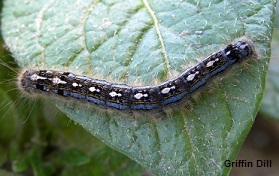Forest and Eastern Tent Caterpillars
Pest Management Fact Sheet #5022
(Malacosoma disstria) and (Malacosoma americanum)
James F. Dill, Pest Management Specialist
Clay A. Kirby, Insect Diagnostician
For information about UMaine Extension programs and resources, visit extension.umaine.edu.
Find more of our publications and books at extension.umaine.edu/publications/.
Description & Biology
The forest tent and eastern tent caterpillars are similar in habits and appearance. Fully grown forest tent caterpillars (larvae) have keyhole-like, or shoe print-shaped, whitish spots on each body segment. This fine line of spots runs down the middle of the back for the entire length of the body. Along each side is a continuous blue line. Their favorite hosts are oak, poplar, maple and birch. The caterpillars do not build nests but leave behind mats of silken threads on trees where they travel or rest.
The eastern tent caterpillar differs in that it has a solid whitish line down the center of the back and an orangish stripe on the sides. They feed on apple, crabapple and cherry trees and build distinctive nests in forks of trees.
- Forest Tent Caterpillar
- Nest
- Eastern Tent Caterpillar and larva
The tent caterpillars lay their overwintering eggs (masses with a dark brown shellacked appearance) around small branches about the size of a pencil. Hatching occurs as buds swell and open, the young caterpillars feed on the buds, and the nests become apparent in late May. As the larvae grow they begin to feed on leaves. When the population increases, it is not uncommon for trees and forests to be defoliated. The caterpillars mature in the first part of June, with adult moths appearing during the last part of the month, when egg-laying takes place. There is one generation per year.
Forest tent caterpillars have denuded forests in many parts of Maine (for five years in a row in some cases in recent years). Trees can usually survive such defoliation, but with reduced growth. Disease, other insects, nutrition, moisture and overall poor condition may cause tree mortality in defoliated trees. Higher defoliating populations of forest tent caterpillars typically drop after two years due to natural conditions, parasites, predators, and diseases. Freezing weather shortly after eggs hatch kills large numbers of caterpillars, and excessively high temperatures later in the spring kills large numbers of adults and reduces the viability of newly-laid eggs.
Management
Management for the eastern tent caterpillar and forest tent caterpillar is similar, except nests of eastern tent caterpillars can be removed and destroyed. Egg masses on branches of small trees around the home can be removed and destroyed before hatching.
Organic methods include using B.t. (Bacillus thuringiensis), spinosad, insecticidal soap (be careful of leaf burning) or neem oil against small larvae. Other insecticides include carbaryl (Sevin®) and malathion.
When Using Pesticides
ALWAYS FOLLOW LABEL DIRECTIONS!
Pest Management Unit
Cooperative Extension Diagnostic and Research Laboratory
17 Godfrey Drive, Orono, ME 04473-1295
1.800.287.0279 (in Maine)
Information in this publication is provided purely for educational purposes. No responsibility is assumed for any problems associated with the use of products or services mentioned. No endorsement of products or companies is intended, nor is criticism of unnamed products or companies implied.
© 2016, 2018, 2020 | Reviewed: 2023
Call 800.287.0274 (in Maine), or 207.581.3188, for information on publications and program offerings from University of Maine Cooperative Extension, or visit extension.umaine.edu.
In complying with the letter and spirit of applicable laws and pursuing its own goals of diversity, the University of Maine System does not discriminate on the grounds of race, color, religion, sex, sexual orientation, transgender status, gender, gender identity or expression, ethnicity, national origin, citizenship status, familial status, ancestry, age, disability physical or mental, genetic information, or veterans or military status in employment, education, and all other programs and activities. The University provides reasonable accommodations to qualified individuals with disabilities upon request. The following person has been designated to handle inquiries regarding non-discrimination policies: Director of Equal Opportunity, 101 Boudreau Hall, University of Maine, Orono, ME 04469-5754, 207.581.1226, TTY 711 (Maine Relay System).




